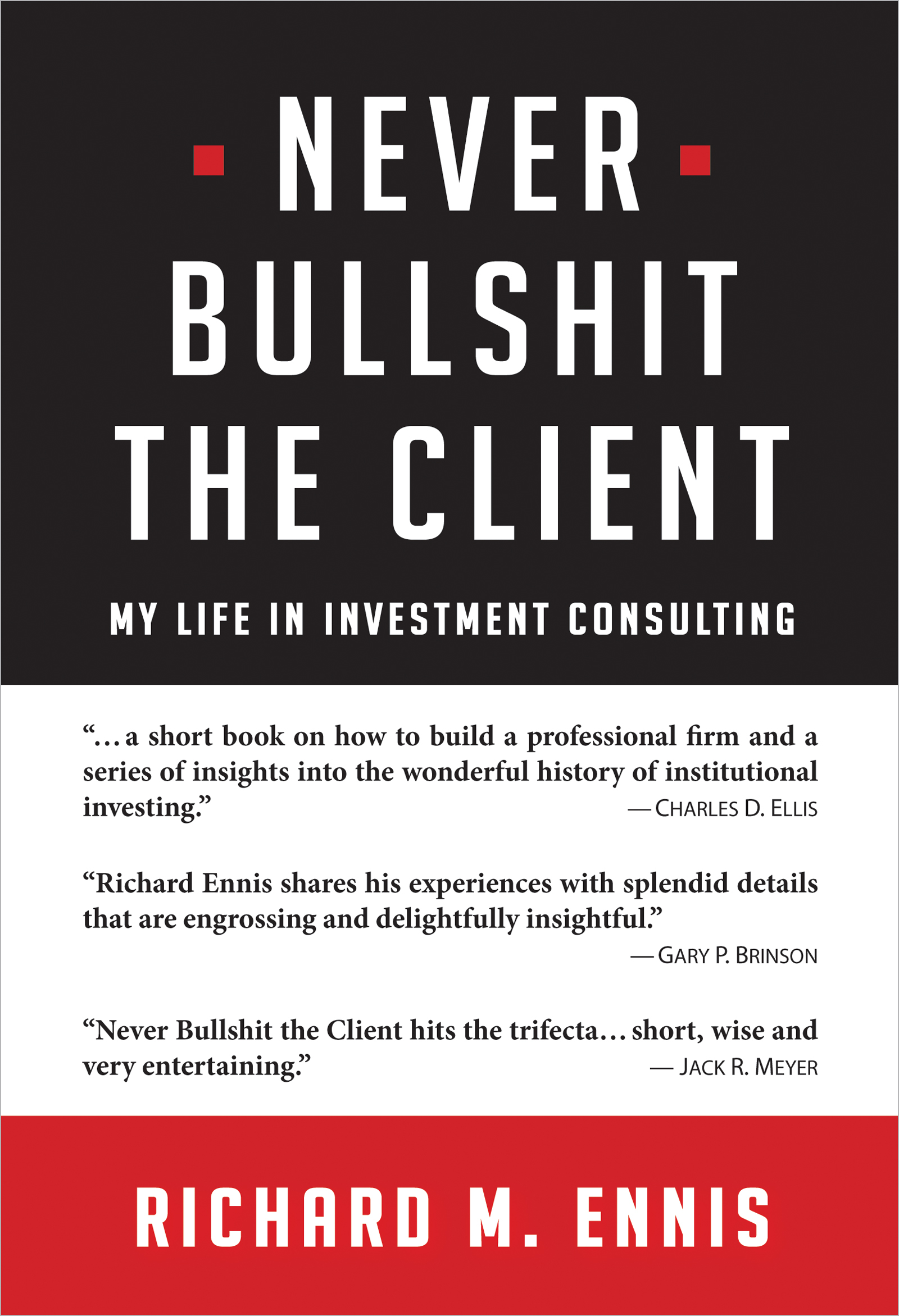An Open Letter to Investment Consultants
Dear Fellow Consultant,
Institutional investors typically underperform passive management by the full margin of their now-very-substantial costs.[1] Most use one or more investment consultants to help manage their portfolios. I believe the consulting profession can play an important role in helping its clients improve performance. I have these recommendations.
- Never BS the client—not even a little. This is serious business.[2]
- It is critical that you establish your accountability with each client. A consultant can be accountable to a board or committee of trustees, a CIO, or another individual in a senior staff position who is not an investment officer. But the consultant cannot be accountable to multiple parties; nor can the consultant’s accountability be ambiguous. Establishing the line of accountability may be an awkward conversation to have with the client if you have been working together for a time without having had it. This merely underscores the importance of having the accountability conversation. The consultant can be accountable to the trustees and work collaboratively with the CIO and other investment staff members. But the latter must understand where the consultant’s accountability lies.
- Everything that consultants advise on does not depend on “client circumstances and objectives.” Too often consultants dance when asked their advisory views. What I learned from my work in the field is that most advisory content can be based on a sound understanding of investment theory and evidence, at least in the consultant’s reading of it. Don’t cop out when asked for your best thinking on investment matters. Be frank. Be clear. There is no better way to build confidence with clients and prospects; plus, be assured that most people know dancing when they see it.
- Speak and write in plain English, and do so in your own voice. Avoid using investment jargon and whatever linguistic fruit salad that seems de rigueur in communicating with clients. There are three reasons for this. One is to ensure specificity and clarity in the important matters you must address. (Warning: speaking/writing this way may require greater forethought.) Another reason is to show respect for the listener/reader: plain speaking, not unlike humility, is a courtesy we do one another. A third is that you will sound more professional.
- Establish firmwide advisory themes. Use them in your work. Put them on your website. Feature them in sales presentations. These might include the firm’s position on the use of active and passive management. For example, the consultant might state:
We recommend that new clients establish an X% allocation of total fund assets to passive investments at the outset of our work together in view of the accumulated evidence favoring passive management over active. From there, clients are encouraged to increase or decrease the passive allocation based on their success with active management relative to a purely passive benchmark [more on the passive benchmark, below].
Other advisory themes might relate to the extent of international equity diversification you advocate, or to the use of alternative investments or smart beta strategies. Advisory themes should square with investment theory and evidence as much as practicable. A primary benefit of having them is that all clients get the same broad guidance, which can then be tailored, as necessary, to client circumstances. This contributes to yours being a one-firm firm and is a natural way to address the centralization-decentralization challenge. Your advisory themes become what you stand for, how you will be known. In my experience, sharing advisory themes in a sales setting can be beneficial. The prospect gets to hear about the thinking underlying the advice they will get, not how you do things or what a great firm you have. The former is of much greater interest to most prospects than is the latter.[3]
- Emphasize actionable investment issues in your research, and don’t shy away from rigor. First and foremost, the consultant is an investment advisor. Do what you can to keep the focus there—that’s where the value is. Too much consultant research seems ho-hum, intended not to offend clients or potential clients. Some gives the impression that its purpose is to merely demonstrate that the consultant is knowledgeable in a particular area. Much of this is descriptive research. Place greater emphasis on research that is analytical or normative. Analytical work “…uses scientific principles to arrive at objective, testable conclusions.”[4] Normative work seeks to identify the best course of action. This would not be original, academic-type work. But it might well incorporate the findings of such work. In this vein, the firm might engage one or more academic advisors to help shape the effort. For sure, the firm should ensure all consultants have access to leading practitioner journals. In any event, in writing for clients, don’t shy away from rigor or otherwise dumb the work down. The clients aren’t dumb, and they value advice that is well supported.
- You must exhibit strength of character and initiative, even when doing so might be difficult. You must speak up when you believe your client is pursuing an activity (e.g., violating their policy) or considering actions that, in your judgment, are not in their or the ultimate beneficiaries’ best interest. You must be prepared to have the client terminate your relationship because someone doesn’t welcome your advice. If you have never been fired under these circumstances, you might benefit from re-examining your protocol in working with clients.
- Every client must have a simple, passively investable benchmark as its principal performance measurement standard. I call this the passive benchmark (PB). The PB reveals whether or not investment management is adding value. The design of the PB should reflect the tastes of trustees of institutional portfolios to the extent feasible. In the field of economics, and as relates to investing, “taste” refers to investor preferences for (1) the level of risk undertaken, (2) liquidity and (3) domestic investments, to name a few. The PB is intended to reflect how trustees, in the absence of insights about the future that active management might exploit, would embrace the capital markets as a matter of policy (and as a function of taste) in delegating investment management of institutional assets. The PB does not incorporate a strategic outlook or any active investment bets. The PB is passively investable and fully transparent, making it feasible. It is only revised when fundamental aspects of taste change. I have found that broad market indexes for US and non-US stocks, plus one for investment-grade US bonds, work well in combination in defining a PB. All other benchmarking at the total fund level must be subordinate to the PB and must not detract from or obscure the message delivered via use of the PB.[5]
- When working directly with trustees (as opposed to a CIO), emphasize to the trustees that they are making a delegation of investment authority. Discourage them from allowing themselves to become involved in the formulation, or the embrace, even, of outlook-based investment decisions, i.e., investment strategy. That is the domain of investment managers. Trustees must preserve their objectivity in order to evaluate the performance of the manager(s) in their delegated function, which is active investing. You can play an important role in helping the client maintain an appropriate division of labor between trustees and investment managers.[6]
- Make an estimate, even if it is a rough one, of each client’s all-inclusive investment costs, and share this with the client periodically. Be sure the client understands that this is the minimum hurdle for gains from active investing. (My research indicates that the average cost across all institutional client types is greater than 100 bps per year, and more than 200 bps for large endowments with their heavy emphasis of alternative investments.) The entire industry has swept the subject of cost under the rug. And yet, cost may be the single most important factor impacting performance.
- Make coaching (mentoring junior professionals) a part of your firm’s culture. When you do this, you educate your younger colleagues. You help them grow. You help them find meaning in their work. Moreover, strong coaches inspire their more junior colleagues. There is no greater gift than inspiration.
Finally, be proud of what you are doing. It is very important work.
Sincerely,
Richard[1] See R.M. Ennis. 2022a. “Are Endowment Managers Better than the Rest?” The Journal of Investing, 31 (6).
[2] See R.M. Ennis. 2019. Never Bullshit the Client: My Life in Investment Consulting. The Carom Press.
[3] See, for example, “Signature EnnisKnupp Advisory Themes” at https://richardmennis.com/blog/5.
[4] “Positive Versus Normative Analysis in Economics,” Thought Co., https://www.thoughtco.com/positive-versus-normative-analysis-1147005
[5] See R.M. Ennis. 2023a. “Lies, Damn Lies and Benchmarks: An Injunction for Trustees.” Journal of Investing, forthcoming; available at SSRN.
[6] I discuss this more fully in R.M. Ennis. 2023b. “When Governance Failed.” Journal of Investing, forthcoming; available at SSRN.

